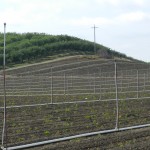
Recent research by the United States Geological Survey (USGS) in the foothills east of Stockton should raise red flags for anyone concerned about the exponential expansion of orchards in eastern Stanislaus and Merced Counties.
The research was conducted in San Joaquin and Calaveras counties as recently as 2011. By far the most alarming discovery was high levels of arsenic in some of the test wells. Most people know of arsenic only as an element in lurid crime fiction, but it occurs naturally in groundwater around the world. It’s often associated with volcanic rock, and its elevated presence in the foothills may be due to the historic lava outflows there.
In a 2008 study, some of the test wells registered arsenic levels high as 60 micrograms per liter. The Environmental Protection Agency (EPA) warns that any amount above 10 micrograms per liter is dangerous. The conventional wisdom is that the deeper you drill, the purer the water. But arsenic levels in some places were actually higher deeper down the aquifer.
Another surprising discovery was the age of the water in the aquifer. Using Carbon 14 dating techniques, the USGS found that most of the water was deposited long ago. The age of this old water
ranged from 2200 to over 13,000 years old. Most likely, the presence of such old water can be explained by the very slow infiltration of surface water that occurs through the typical fractured rock surface in the foothills.
While no such research has been done in Stanislaus and Merced Counties, the geological formations there are similar to the USGS study areas. And there are some very good reasons to find out soon whether or not there are high arsenic levels in Stanislaus and Merced County groundwater.
For one thing, we already know that many of the wells in the foothills are deep. They are drilled deep enough to provide sufficient pressure for drip irrigation up and down hill. We also know that the aquifer on the east side is dropping fast—wells are going dry by the dozens.
Drip irrigation is marvelously efficient. It provides just enough water for the crop and no more. That means the only way the aquifer is recharged is by rainfall and snowmelt. Given the almost glacially slow recharge period and the prodigious amounts of water pumped daily, the only recourse to keep crops alive and family wells pumping is to drill ever deeper, which is already happening on a grand scale.
Some of the deeper water may well contain dangerously high levels of arsenic. If so, it would be better to find out by means of scientific research than wait for a diagnosis of arsenic-poisoned residents of the east side.
Because California state government has never addressed groundwater law, it’s the responsibility of local irrigation districts and county supervisors to oversee and regulate groundwater use. Right now, they’ve abdicated, and the rule of law is pure fantasy. The rules instead are made by the people with the biggest pumps. The consequences will not only be costly to the public, they may well become deadly.

“arsenic occurs naturally in groundwater around the world.”
this may be true and too often said ,
but the dirty truth is that arsenic is also used in factory chicken farms
and when the stinky waste products are used as fertilizer on valley farm land
it adds to the arsenic levels of the food and quickly gets back in to the water supply.
ps , you might not want to eat that chicken and also now showing up in rice.
The lack of groundwater withdrawal monitoring and regulation sorely needs to be addressed. Two free local events are coming up at MJC about it:
• Dr. Nick Pinhey, Sept. 25, “Groundwater in California: Hydrology and Politics” Location: Science Community Center, MJC West Room 115, 3-4 pm.
• Chris Petersen, Groundwater Practice Leader at West Yost Associates will be presenting a Modesto Area Partners in Science talk on groundwater and conjunctive use, 7:30 pm at MJC either Oct. 25 or Dec. 06 -check out http://maps.events.mjc.edu/ for details.